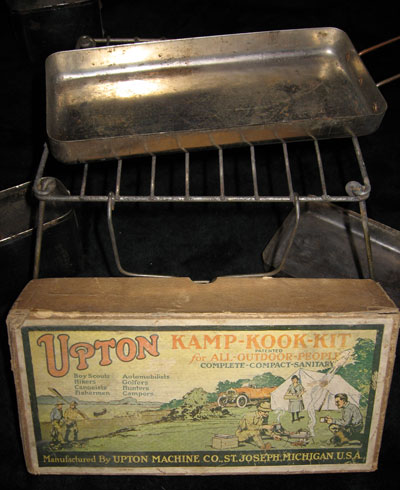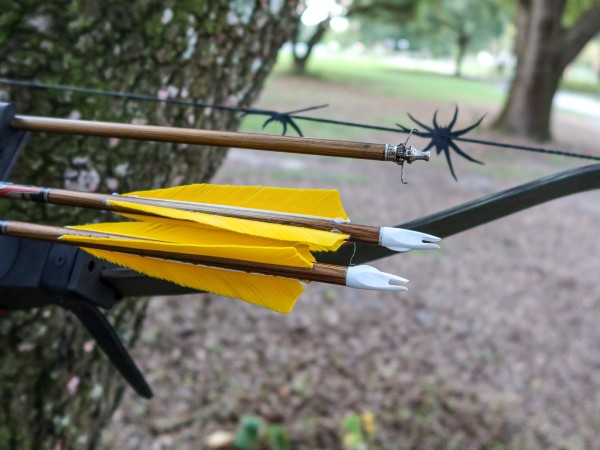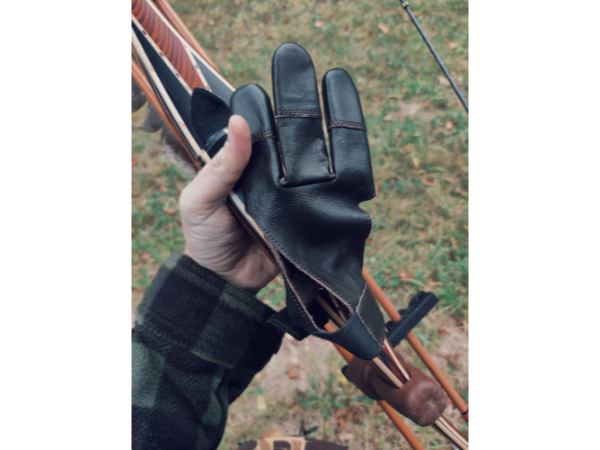Saxton Pope and Arthur Young’s hunting adventures in the early part of the last century are well documented. In Pope’s book Hunting with the Bow & Arrow, published in 1923, the author devotes many pages to descriptions of days spent in the rugged California hills stalking deer, bear, and mountain lion.
Pope tells us: “To go deer hunting, the archer should seek a country unspoiled by civilization and gunpowder. It should approach as nearly as possible the pristine wilderness of our forefathers.” So, we know that these pioneer bowhunters must have spent many days and nights in remote places. And although we are told much about their archery paraphernalia and hunting methods through Pope’s descriptions, little is said about the camps the archers must have stayed in or the gear they relied upon.
What was included in an early 20th century bowhunter’s “outfit”? What did they eat, what were their tents like, and how did hunters cope with hoards of bugs long before the development of DEET? These are some of the details which were evidently deemed too mundane to discuss in the writings of the time.
A window as to how hunting camps were set up during those days opened a bit when I ran across a small, brown book titled The Outdoorsman’s Handbook. Published in 1920 under the auspices of Field & Stream, it provides a look at the state of camping at that time and, most likely, how it largely remained until technical developments during World War II revolutionized living outdoors.
All of the many illustrations in the Handbook look absurdly out of date, of course–like a picture of a pitched “automobile tent” with its back side attached to what appears to be a Stutz Bearcat. The most popular style of tent at that time seems to have been the timeless wall tent, which, on the page at least, doesn’t look much different from those of today.
“Practically all of the trappers, lumbermen and herb men who live in the woods use the wall tent, and the Indian abandons his tepee for it just as soon as he can afford to buy one,” the reader is told. These tents were usually made of waterproof flax or duck and could weigh as much as 81 pounds. Other popular models were those with open sides, such as the “Dan Beard” and “Baker” tent, the latter called “a standard woodsman and hunter tent universally popular in Canada and the North Woods”. These were basically wall tents with one side sheared off and guyed straight out, forming a sort of veranda. The advantage of the design was that it enabled one to build an open fire in front for heating at night and cooking during a rain.
Since the tents of the time did not include bug netting, the Handbook addresses the problem of being exposed to biting insects: “You will be pestered and henpecked by the bloodthirsty demons (mosquitoes) with increasing emphasis as the hours of the night progress. The recommendation is to take along some netting woven fine enough to also be gnat-proof and punkie-proof.”
Since you couldn’t buy it commercially at that time, there is a recipe for cooking up some “fly dope” that includes such common household items as pennyroyal oil, pine tar, creosote, and camphor.
The photos in Pope’s book show the bowhunters wearing boots that come up to mid-calf. These are illustrated in the Handbook and simply called “hunting boots” It is noted that when ordering them “all of them (manufacturers) append an order blank with measuring diagrams, so as to fit you by mail, and some factories will make the entire boot to order if they cannot fit the measurement with stock sizes.”
More highly recommended than the hunting boot, however, is a high, moose hide moccasin called a larrigan. “With them,” the handbook tells us, “you can run over windfalls, along down trees, up steep rock escarpments, down rocky streams and across muddy bogs with equal facility, and you will be dancing a jig by nightfall, when the man with heavy boots can only sit on a log and blink at you.”
If those hunting boots caused sore feet, there was a remedy for that too: Soak the feet well and rub with soap, tallow, or Vaseline and coat the inside of the socks with soap.
Since Pope was a physician, his camp’s medical emergencies would have been expertly handled. Hunters without a doctor, however, needed more advanced medical advice than just how to treat blisters. The Camp Medicine section starts out with the ominous words, “To begin with, there should be a few surgical instruments…” We’re then given a description of how to deal with a choking victim by performing a do-it-yourself fireside tracheotomy using your jack knife. Another paragraph addresses how to treat a mad dog bite by “cauterizing the site with a white-hot iron at once,” or “cutting out adjoining parts with a sharp knife.” Ouch.
To modern bowhunters, some of these “remedies” might sound worse than the injuries they were supposed to cure. But in the days before cell phones and medivac choppers, they were probably the only choice other than choking to death or losing a hand to gangrene.
There’s a photo in Hunting with the Bow and Arrow showing Compton and Young holding arrows on which quail are impaled, but those birds were probably prepared differently from the way they would be today. “Grouse, quail, snipe, woodcock and other game must hang several days before cooking, and a woodcock’s innards need not be removed before cooking, as it easier to do so afterwards.”
Recipes for opossum, muskrat, and turtle soup also appear, since hunters would sometimes supplement their groceries with these targets of opportunity. Indeed, as Pope tells us: “There is always meat for the shooting.” Popular camp dishes from that era included hasty pudding and fried mush (left over hasty pudding which is fried in pork fat and served with molasses). There are also instructions for roasting a whole venison haunch over an open fire.
Flapjacks were to be flipped: “The solemn ceremony of flopping the cake takes place by which the cake is tossed in the air and caught elegantly and precisely raw side down in the pan as it falls. Don’t mind a failure or two for nothing contributes more surely to the gaiety of nations and of camps than to behold the writhing disk shot confidently skyward, only to fall ignominiously among the blue flames of the campfire.”
How much did all these provisions weigh? A “canoe travel list for three men for 26 days” tips the scale at a whopping 360 pounds! Included near the bottom are “two bottles of painkiller”, which were probably necessary after lugging all that grub across the portages.
Pope, being far more Spartan, gives us a clear picture as to what he took on the trail when he states: “The ideal way for an archer to travel is to carry on his shoulders a knapsack containing a light sleeping bag and enough food to last him a week. With me, this means coffee, tea, sugar, canned milk, dried fruit, rice, cornmeal, flour and baking powder mixture, a little bacon, butter and seasoning. This will weigh less than ten pounds.”
 Although one might picture the camp’s cooking equipment as an assortment of ponderous cast iron pots and pans, aluminum was already in use. The idea of miniaturizing and compacting the outfit–especially for packing in–seemed to be taking hold. The “Upton Kook Kit”—nesting pots, cups, and fry pans all fitted into a package—is a good example of cutting-edge camping equipment of the 1920’s.
Although one might picture the camp’s cooking equipment as an assortment of ponderous cast iron pots and pans, aluminum was already in use. The idea of miniaturizing and compacting the outfit–especially for packing in–seemed to be taking hold. The “Upton Kook Kit”—nesting pots, cups, and fry pans all fitted into a package—is a good example of cutting-edge camping equipment of the 1920’s.
Sleeping bags were made up of two parts. The waterproof outside cover protected the inner parts, which were usually blankets, “puffs”, or layers of what was non-descriptively called the “inner bag”. Surprisingly, by this time the air mattress was already making its appearance, while down and feather quilts were being used in cold conditions.
One piece of gear around camp that was not compact, however, was the hunting knife. Sheath knives with blades of six to even eight inches were popular: “These are considered among the best models of hunting knives made.” And, since the steel of that period was not nearly as tough as today’s, a couple of good sharpening stones were part of any outfit.
Although Pope tells of field dressing several of their big game kills after dark with flashlights, carbide lamps seem to have still been the favorite, and a number of styles are illustrated in the Handbook. A candle lamp is also shown, and we are advised to “Take along half a dozen candles as the gas lamp gives out just at bedtime.”
The chapter on camping ends with some bits of advice to all who venture out into the wilds. Among them are:
- “Do not sit or lie on the bare ground; it is harmful and likely to cause sickness.”
- “If your horse won’t drink water don’t do it yourself; trust your horse, but don’t trust your dog, for he will drink any filthy water.”
- “To avoid sore feet, wear large shoes with small hob nails that cannot be felt through the soles.”
- “If your boots are wet, scrape away some hot dirt or sand from under the fire and fill them with it. They will be dry in the morning.”
- “Talk to your horse or dog–he is just as lonely as you are.”
This was camping as Pope, Young, and Compton must have known it, as well as several generations of bowhunters who came after them. It was decidedly primitive by today’s measure, but the outdoorsmen of the time never seemed to feel that they were roughing it. Heavy tents, food packs weighed down with raw potatoes and tins of lard, bulky sleeping rolls and a scarcity of things that might have added to creature comfort were all part of living in the wild—an experience that these hardy pioneers of bowhunting seemed to relish.
We’ve come a long way, baby… I guess.







I spent most of my life hunting like that, as ive got older, now in my 60s, ive got smarter
I always enjoy Duncan’s articles!
I think those fellows were tougher then than we are now. I have a camping book written i n the days before sleeping bags which suggests that a flannel shirt for the day and a thin wool blanket for the night is all that is needed for temperatures that don’t dip below zero. burr….